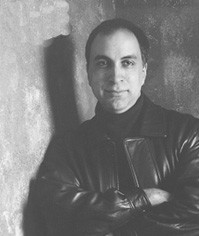
Composer Anthony Cornicello (born in Brooklyn, New York, 1964) writes music that blurs distinctions between performers and electronics, timbre and harmony, composition and improvisation, and explores the boundaries of what may be considered post-classical concert music. His music is vibrant and visceral, full of rhythmic energy and harmonic sophistication, and his forays into live electronics have led to exciting combinations of instruments and processed sound. Cornicello’s background as a jazz pianist is evident not only in the rhythmic activity of his music, but also in his constant investigation of the rich sonorities available from a variety of instruments.
He has been commissioned to write music for the Scorchio Electric String Quartet, ModernWorks! (funding from Meet the Composer/ Commissioning Music USA), the Auros Group for New Music, the Prism Saxophone Quartet, the New York New Music Ensemble, David Holzman, the Group for Contemporary Music, and the InterEnsemble of Padova, Italy. His work has also been featured on the Guggenheim Museum’s “Works and Process” series. Cornicello’s works have also been performed by the Chicago Civic Symphony, Parnassus, ALEA III, Composers Concordance, Madeleine Shapiro, Robert Black, among many other outstanding groups and solo performers. His music has been presented as part of the Darmstadt International Festival of New Music as well as the June in Buffalo Festival.
Cornicello’s Second String Quartet has been recorded by the Atlantic String Quartet; the Second Sonata for Piano by David Holzman (Centaur). More recently, his Post-Modern Waltz was recorded by Eric Moe for Albany Records. A portrait CD of Cornicello’s works is scheduled for 2006 release on Albany Records.
As a performer, he has conducted or played piano in his own works on numerous occasions. While a graduate student at Rutgers, he formed and directed the Janus Ensemble, a group dedicated to contemporary music. More recently, Cornicello has begun performing on the laptop, using a variety of interfaces and the Max/MSP program. Those performances, mostly with EEE!, have had a notable impact on his music, as EEE!’s music ranges from hip-hop to experimental noise. EEE! is based at Eastern Connecticut State University, where Cornicello is an Associate Professor and Director of the Electronic Music Lab.
Cornicello received the Ph.D. from Brandeis University, where he studied with David Rakowski, Eric Chasalow, and Martin Boykan. His teachers also include Charles Wuorinen, Gérard Grisey, and Richard Beirach.
His current fields of interest include developing unusual interfaces for live computer music performances, as well as continuing to investigate resonance and spatialization. His recent and current projects (mostly for string instruments and electronics) have been exploring the latter two, and the series of experimental works ReZenant Garden, performed by EEE! have operated on all three areas of interest. Future projects will include works for instrumental groups or soloists and electronics, as well as turntablists.
Cornicello's works are published by C.F. Peters Corporation and APNM, and he is a member of BMI.
|
|
|
|
|
|

Wednesday, August 17, 2005
Recording
Earlier this week, Robert Black recorded my solo bass piece Static Walking. I wrote it for Robert back in 1997, and he's been playing it on and off ever since. So has Steve Gilwelski, who has also toured with the piece. We recorded the piece for Albany Records, who will release a CD of my music when it's all done. We have a while to go....
Anyway, what always amazes me is how recording technology has changed during my lifetime (I'm 41, BTW). When I first went into a studio it was 1982. My jazz-fusion group did a demo recording of five tunes. I remember that big mixing console, the reel-to-reel tape. We paid for everything, of course, even a transfer to cassette (wow, talk about high quality!). Everything was done with master takes, more or less complete run-throughs of the tunes. I think we overdubbed one sax solo and some percussion.
The next recording projects I was involved with was in the early 90s. In both those instances (not in a studio, mind you), the music was recorded to a DAT tape. And from here on, I became directly involved with editing. For those of you who haven't done this, it involves piecing together all the takes into a master 'map' of the work. I'm always amazed at how the first time through you can hear the edits, but afterwards, the effect is gone and you only hear the complete work.
On more recent projects (as I prepare for the Albany CD), the recording is now done direct to hard-drive. In a way this isn't shocking to me - I teach electronic music. But still you'd think "the pros must use some sophisticated (sophistimacated?) devices that we don't even know about". You know, the equivalent of those fancy espresso machines that you only see in coffee shops. But no, Monday's session was run (by Scott Metcalfe) on a PowerBook. He'll transfer it to his G5 for the final editing.
In the earlier days, I was either handed a cassette or a DAT tape to do my editing picks. When we were finished, Scott handed me a CD, with the track numbers matched up to the takes. (Since Static Walking is only 5 minutes long, we only had around 23 takes) Amazing!
I also know that there are programs that do non-destructive edits. So the program reads through the piece, at the start/stop points of all your edits, but leaves the others intact. Just in case you notice, for instance, that one chord is flubbed in your 'good' take but attacked a little clearer in another.
So the gadget-loving geek that I am is wondering: what's next for recording technology?
posted by Anthony Cornicello
|
| |



